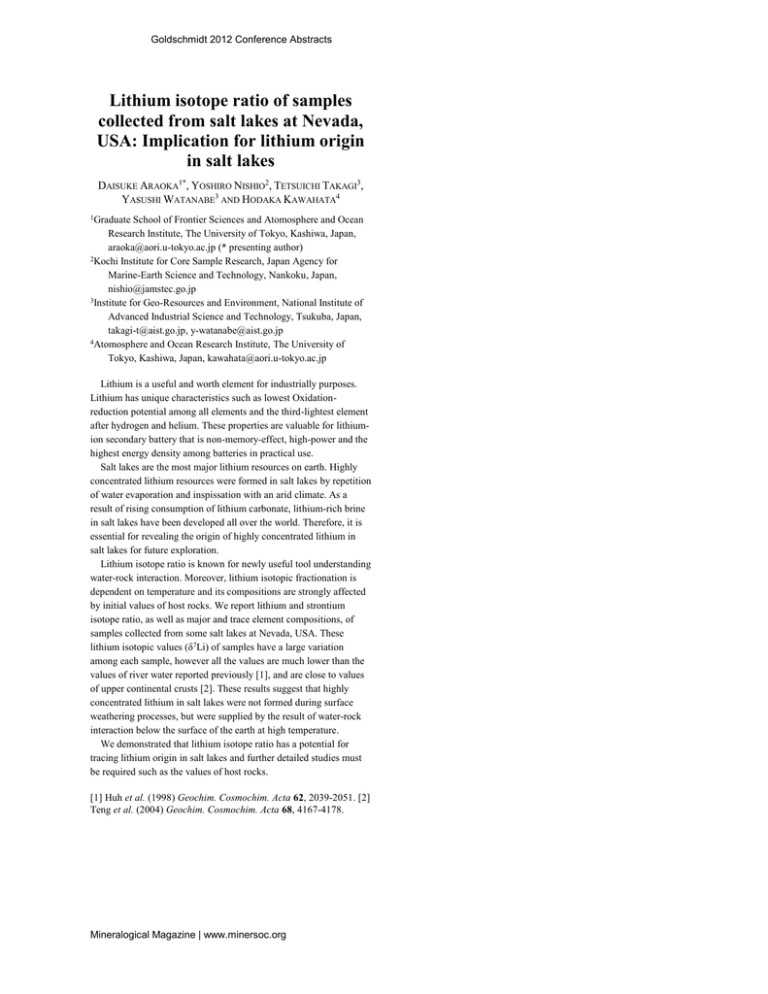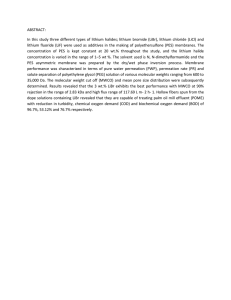Lithium isotope ratio of samples collected from salt lakes at Nevada,
advertisement

Goldschmidt 2012 Conference Abstracts Lithium isotope ratio of samples collected from salt lakes at Nevada, USA: Implication for lithium origin in salt lakes DAISUKE ARAOKA1*, YOSHIRO NISHIO2, TETSUICHI TAKAGI3, YASUSHI WATANABE3 AND HODAKA KAWAHATA4 1Graduate School of Frontier Sciences and Atomosphere and Ocean Research Institute, The University of Tokyo, Kashiwa, Japan, araoka@aori.u-tokyo.ac.jp (* presenting author) 2Kochi Institute for Core Sample Research, Japan Agency for Marine-Earth Science and Technology, Nankoku, Japan, nishio@jamstec.go.jp 3Institute for Geo-Resources and Environment, National Institute of Advanced Industrial Science and Technology, Tsukuba, Japan, takagi-t@aist.go.jp, y-watanabe@aist.go.jp 4Atomosphere and Ocean Research Institute, The University of Tokyo, Kashiwa, Japan, kawahata@aori.u-tokyo.ac.jp Lithium is a useful and worth element for industrially purposes. Lithium has unique characteristics such as lowest Oxidationreduction potential among all elements and the third-lightest element after hydrogen and helium. These properties are valuable for lithiumion secondary battery that is non-memory-effect, high-power and the highest energy density among batteries in practical use. Salt lakes are the most major lithium resources on earth. Highly concentrated lithium resources were formed in salt lakes by repetition of water evaporation and inspissation with an arid climate. As a result of rising consumption of lithium carbonate, lithium-rich brine in salt lakes have been developed all over the world. Therefore, it is essential for revealing the origin of highly concentrated lithium in salt lakes for future exploration. Lithium isotope ratio is known for newly useful tool understanding water-rock interaction. Moreover, lithium isotopic fractionation is dependent on temperature and its compositions are strongly affected by initial values of host rocks. We report lithium and strontium isotope ratio, as well as major and trace element compositions, of samples collected from some salt lakes at Nevada, USA. These lithium isotopic values (δ7Li) of samples have a large variation among each sample, however all the values are much lower than the values of river water reported previously [1], and are close to values of upper continental crusts [2]. These results suggest that highly concentrated lithium in salt lakes were not formed during surface weathering processes, but were supplied by the result of water-rock interaction below the surface of the earth at high temperature. We demonstrated that lithium isotope ratio has a potential for tracing lithium origin in salt lakes and further detailed studies must be required such as the values of host rocks. [1] Huh et al. (1998) Geochim. Cosmochim. Acta 62, 2039-2051. [2] Teng et al. (2004) Geochim. Cosmochim. Acta 68, 4167-4178. Mineralogical Magazine | www.minersoc.org

